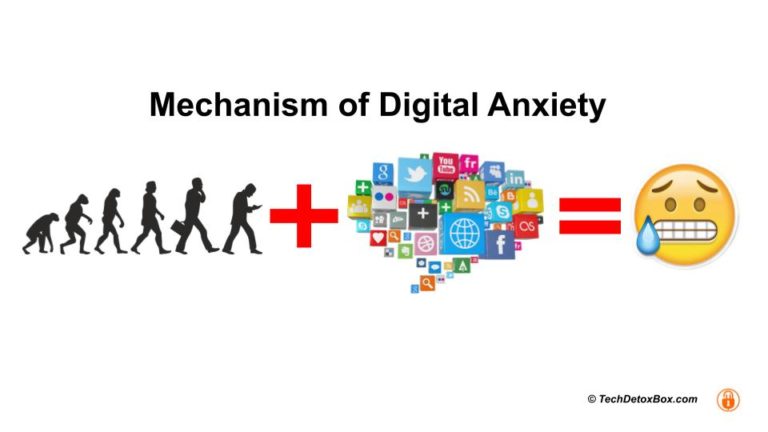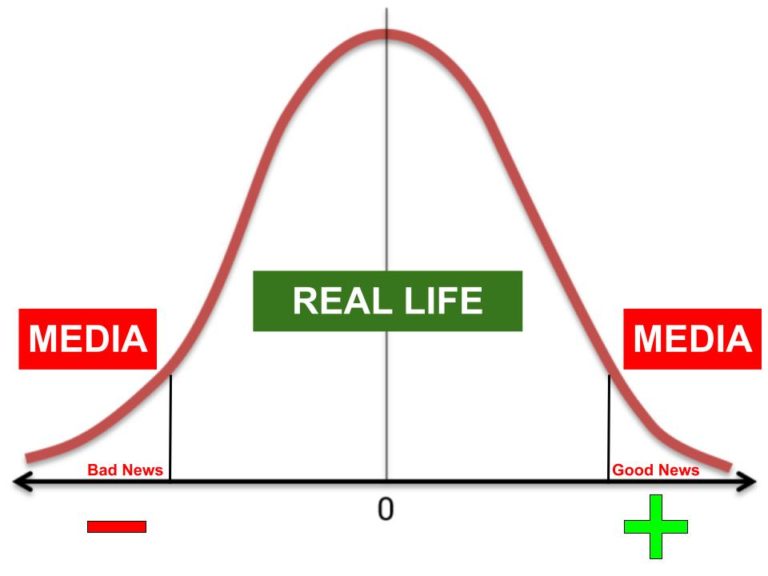
The Mechanism of Digital Anxiety
The more we stare at our screens, the more they bombard us with traumatic news and shred our nerves with social media battles. At the end of the day, we feel inadequate, anxious, depressed, scared, overwhelmed, and hopeless.
What is the mechanism of this digital anxiety that seems to plague each of us, myself included?
There are 3 questions to unpack here:
- Why is digital media so negative?
- How does it make us feel bad?
- What can we do to feel better?
Let’s start with human nature.
Why All the Bad News?
It’s a known psychological fact that pain is a more powerful motivator than pleasure. Negative cues in the environment capture attention better than positive ones. This makes evolutionary sense: our brains process threats faster because threats can kill you. We react instantly, there is no time to think. The emotions of fear, anger, and disgust override our rational judgment and drive our behavior online and in the real world.
Which makes media content geared for anxiety and outrage spread so much faster and generate much more traffic than any good news. Images of doom fill our screens, and our nervous system is kept on high alert by chronic stress.
All of it by design.
Our subconscious sensitivity to all things negative is used by digital media without our awareness. Negativity bias that served humans well as a mechanism of survival, became a vulnerability to be exploited for profit.
Our evolutionary biology has prepared us for the world of hunter-gatherers, not for the world of notifications.
Good News Makes Me Feel… Bad?
Wait a minute, you might say – there is plenty of good news reported online – it’s just that they only seem to happen to other people. As we compare our lives to the fabulous lives of our friends on social media, instead of feeling happy for them, we succumb to negative emotions of envy, shame, and self-doubt.
The pain of social comparison is not a recipe for happiness. I do not post photos of my kids and vacations on social media largely to avoid this trap. If I compare myself to others I would either:
- Feel inadequate (if their lives look better – which they always do on social media), or
- Feel superior (by making others feel worse in comparison to me – which is plain nasty).
Why can’t we just be content as our own unique individuals?
Digitally Engineered Anxiety
So there you have it:
Bad news from the world result in fear and hopelessness, and
Good news from other people result in envy and self-loathing.
If all this negativity is the only thing we upload into our brains for an average of 11 hours of screen time a day, no wonder we feel anxious.
Plus, when we think bad news is all there is, we have another cognitive bias to blame for our anxiety.
Availability bias is a mental shortcut in our brain that allows us to save energy when we make decisions. We rely on whatever comes to mind first. And what usually comes to mind is something that we recently heard or read about: it’s readily available and easily retrieved.
Information that is easy to remember becomes the most relevant. Even when it’s wrong.
This is how social psychologist Robert Cialdini describes this mechanism in his book Influence:
“When we are rushed, stressed, uncertain, indifferent, distracted, or fatigued, we tend to focus on less of the information available to us. When making decisions under these circumstances, we often revert to a rather primitive but necessary single piece of good evidence approach”.
We are shaped by our experience. Many of our actions are not made by deliberate conscious choice, but by the most obvious option that pops into our mind, relevant data that we have seen recently – or frequently. Coffee means Starbucks.
The availability bias argument for digital anxiety simply states that if all available information we consume is anxiety-producing, then yes, we would predictably become – and remain – anxious.
Since most of us do not consciously control what’s available on our screens, they would be algorithmically filled with negative content to maximize our user engagement. Good news is not news, because it lacks the shock value. As the old saying in journalism goes: “if it bleeds, it leads”.
With our attention being biologically limited and negativity bias in charge, we prioritize the most important threats and opportunities – but only those we happen to know about. And the ones we know about are the ones algorithms place on our screens for the benefit of third parties.
We become what we think: garbage in – garbage out.
Program your brain with negative content – and your brain would respond by running the algorithm of depression and anxiety.
If bad news is all we see on our screens, availability bias deceives us into believing the world is falling apart, humanity is hopeless, there is nothing to feel good about, and there is no point trying to change things.
But that’s not true.
The Antidote to Digital Anxiety
We would do a favor to our wellbeing if we become our own content curators instead of leaving it to the artificial intelligence behind our social media feeds that couldn’t care less about how we feel.
Make good news available for your availability bias: the antidote to digital anxiety is to program your brain with gratitude for what is going well instead.
The founder of Positive Psychology, Martin Seligman, writes in his book Learned Optimism:
“Negative beliefs are distortions. Challenge them. Don’t let them run your emotional life.”
His recipe goes like this:
- “First, you learn to recognize the automatic thoughts flitting through your consciousness at the times you feel worst.”
- “Second, you learn to dispute the automatic thoughts by marshaling contrary evidence.”
- “Third, you learn to make different explanations, and use them to dispute your automatic thoughts.”
What is that contrary evidence to our negative view of the world and our own life?
It happens to be reality itself – not the extremes magnified by digital media but the actual reality, the vast majority of it – regular life that never makes the news.
Do you remember the bell-shaped curve from statistics? Events also follow this “normal distribution”: extremes in the tails, with the majority of data points in the middle.
Guess what gets magnified by news and social media? That’s right – the extremes. Extreme pleasure or extreme pain. Celebrity lifestyles or genocide. Far right or far left.

However, most of us live in the middle, leading uneventful lives that just don’t have enough drama to make the news. We are boring. Sorry.
But this is actually good news. Despite wars and pandemics, life has never been safer and more prosperous than it is now. Matt Ridley in his book The Rational Optimist: How Prosperity Evolves analyzes the entire history of humanity to prove that things are getting better – not worse. Life span, availability of food, incomes are up; disease, child mortality, and violence are down all over the world. Productivity and innovation solves problems as they appear. This is meant to lift your spirits – reading the news does the opposite.
The problem with digital media is that it caters to the emotional brain that scans all incoming data for survival. It turns our fight or flight response permanently on, at the time when most threats are not immediate. But the amygdala does not know the difference and reacts the same way it did 50,000 years ago – it goes on high alert.
Overwhelmed by emotions, we forget that the media’s view of the world does not reflect reality which has improved a lot since the age of hunting and gathering our brain evolved for.
It’s time to turn our rational brain back on and realize that we do have it pretty good.



